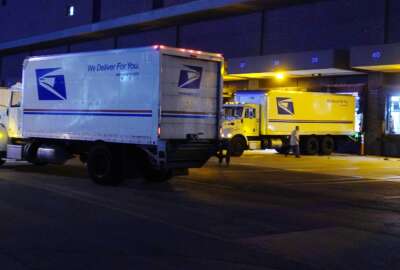
The Postal Service’s experiment with automated vehicles sort of fizzled
A few years back, the Postal Service purchased 350 automated-guided vehicles to move pallets in its processing center. But according to the USPS Office of...
Self-driving vehicles are nothing new. They’ve been operating inside warehouses and factories for decades. A few years back, the Postal Service purchased 350 automated-guided vehicles to move pallets in its processing center. But according to the USPS Office of Inspector General, the experiment didn’t quite work out. For more, Federal Drive host Tom Temin spoke with audit director Todd Watson.
Interview transcript:
Tom Temin And let’s begin with what they were trying to do here.
Todd Watson Right. So the Postal Service invested in automated guided vehicles, which are self-driving forklifts or tuggers that will move mail from a dock when it comes in off a truck into the work room floor to be sorted by machines. And then when a machine sorts it, they will take the mail back to the dock. And so the Postal service invested in this to try and reduce work hours associated with people that would have to manually drive the mail between the dock and work on floor.
Tom Temin This is very short distances, maybe a couple of hundred yards at a time.
Todd Watson Correct. Correct. Postal Service had expected this would save about $298 million by reducing the amount of human work hours associated with this work.
Tom Temin And these were commercial standard types of automated vehicles that you might find in, you know, an Amazon warehouse or, you know, UPS or something.
Todd Watson Correct. This was a third party vendor that sold these machines to different companies to use in their warehouses.
Tom Temin And just a quick question. In your report on this, the amount they spent on them is redacted. I’m just curious as to why that’s the case.
Todd Watson Well, the Postal Service felt like they would lose some competitive advantage if it disclosed how much cost was associated with this investment.
Tom Temin Or they paid too much and they don’t want anyone to know. But we’ll speculate on that one, I guess. So what happened when they deployed these 350 devices, gadgets, robots?
Todd Watson So we found that the Postal Service did not meet its goals for using AGVs. Initially they expected to operate each AGV 40 hours per week. However, we found almost a quarter of the ads weren’t used once in over a year. And additionally, we found another quarter that were used on average about once per day. So as a result, we questioned costs totaling $28 million related to the purchase of those underutilized AGVs. And we also estimated that post office would fall short of their projected savings by at least $105 million.
Tom Temin Yeah. And are these things still deployed or what’s the status now? Because these were purchased back in 2019.
Todd Watson Right. So they’re still deployed. What the Postal Service told us is why they didn’t use and what we found by interviewing local management was they were deployed in 2019. And right after that is when COVID happened and there was a big surge of package volume. And that caused a lot of issues for the Postal Service. One, it created congestion in their facilities. They didn’t have enough space to house all of those packages. And these self-driving AGVs need clear aisle ways to be able to operate. If there’s an obstruction in this way, it would just stop and not be able to complete to its destination. Additionally, the post office kind of rearranged some of their facilities, moving machines in and out and in different places to try and increase the flow. However, these AGVs were programed to go to a certain location, and so when that was changed, we found the local facility did not have the knowledge or expertise to be able to update the routing information on these AGVs.
Tom Temin Right. So it sounds like some planning for contingencies or for updating, which you’d probably want to do even without the pandemic coming in. Because if you have this gadget, we’ll maybe want it to go down aisle three today instead of aisle five.
Todd Watson Right. And that’s what we found. There were a few higher performing facilities that were able to use AGVs effectively. And what we found was they made sure they had clear aisle ways for the AGVs to go down and they also were able to pretty much teach themselves by communicating with that third party vendor on how to change and update routes and pick up and drop off locations. So we made a recommendation to the Postal Service to go ahead and share some of those best practices that those sites that are actually using them learned to increase the overall usage of the Postal Service.
Tom Temin We’re speaking with Todd Watson. He’s audit director at the Postal Service’s Office of Inspector General. So, in other words, they can salvage this if they I mean, the machines are still there. They sound like they are still fairly new and guessing because it’s a factory capital piece of gear. They probably last a long time.
Todd Watson Correct. There are some locations where this is working really well. Postal Service contends that some of the locations they deployed them that work the best, especially after that COVID spike of packages. And so we also recommended that the Postal Service kind of develop and execute a plan to evaluate locations that would be best suited for these AGVs and then go ahead and deploy them to those locations to help increase the usefulness.
Tom Temin These are commercial AGVs, which means other commercial entities use them. Could the Postal Service get some information from another client. It’s probably someone the Postal Service already does business with.
Todd Watson Certainly, that was an avenue they can go down. You know, they contracted with a vendor to provide these machines and certainly they could provide additional support to the Postal Service if needed.
Tom Temin And what about managing them? That is to say, should one person on a shift or one person in a facility have quote unquote, ownership of a given AGV? And they could name it Betty or something, and then they would be responsible for programing, maintaining it and making sure it’s used to greatest efficiency. I mean, that’s how a lot of these things tend to work.
Todd Watson Absolutely. At the places we saw where they were being used effectively, the people were really engaged with the machines. They saw the benefit and really enjoyed using them to complete the task of moving mail through the facility. And so they kind of rallied around those machines and really believed them.
Tom Temin And your staff visited several sites. For example, Middlesex Essex in North Redding, Massachusetts, had low use, for example, one of many that had low uses. But the Music City annex in Nashville and the Oklahoma City annex in Oklahoma City, they had high usage. Is there a plan for the high usage facilities to share what they know with Los Angeles, Seminole, Royal Palm, etc.? Nashua, New Hampshire, where the utilization is low?
Todd Watson Correct. And that was the recommendation we made to the Postal Service was kind of share these best practices of how it was successful in the locations that are doing well, to share that with the locations that are not doing as well.
Tom Temin And how did USPS take the recommendations?
Todd Watson Well, they disagreed with some of our findings in the report, but they actually agreed and will implement all of our recommendations. So that should correct the low usage if they are able to implement our recommendations.
Tom Temin And this was, I’m sure, way outside the scope of study. But as the Postal Service contemplates just because everybody thinks this is the way the world should go, not for any particular known practical reason self-driving, say, route delivery vehicles. Is there anything learnings that could translate from these warehouse type equipment to someday self delivering out on routes? I mean, does anything translate over from one domain to the other?
Todd Watson Well, certainly as the Postal Service is investing in new technology, just learning how to deploy new technology, the knowledge needed and the coordination needed to make it successful. And as the Postal Service is implementing, it’s delivering for America its ten year plan to achieve service excellence and financial stability. They’re planning to invest $40 billion in its processing delivery and logistics network. And so as it invests that money, it’ll be important for them to invest in options that improve the efficiency and effectiveness of the Postal Service.
Tom Temin It sounds like in a lot of these cases, it’s not the technology that’s really at an issue because, I mean, really, I read and wrote about self-driving AGVs literally 40 years ago in factories. They they had a magnetic stripe on the floor or there was different technologies to guide them. I’m sure that’s come a long way, but it’s the management of it and the planning for it more than the tech itself, isn’t it?
Todd Watson That is correct. You know, when there’s a change to how you do operations, there’s always a learning curve for implementing and getting better.
Copyright © 2025 Federal News Network. All rights reserved. This website is not intended for users located within the European Economic Area.
Tom Temin is host of the Federal Drive and has been providing insight on federal technology and management issues for more than 30 years.
Follow @tteminWFED




